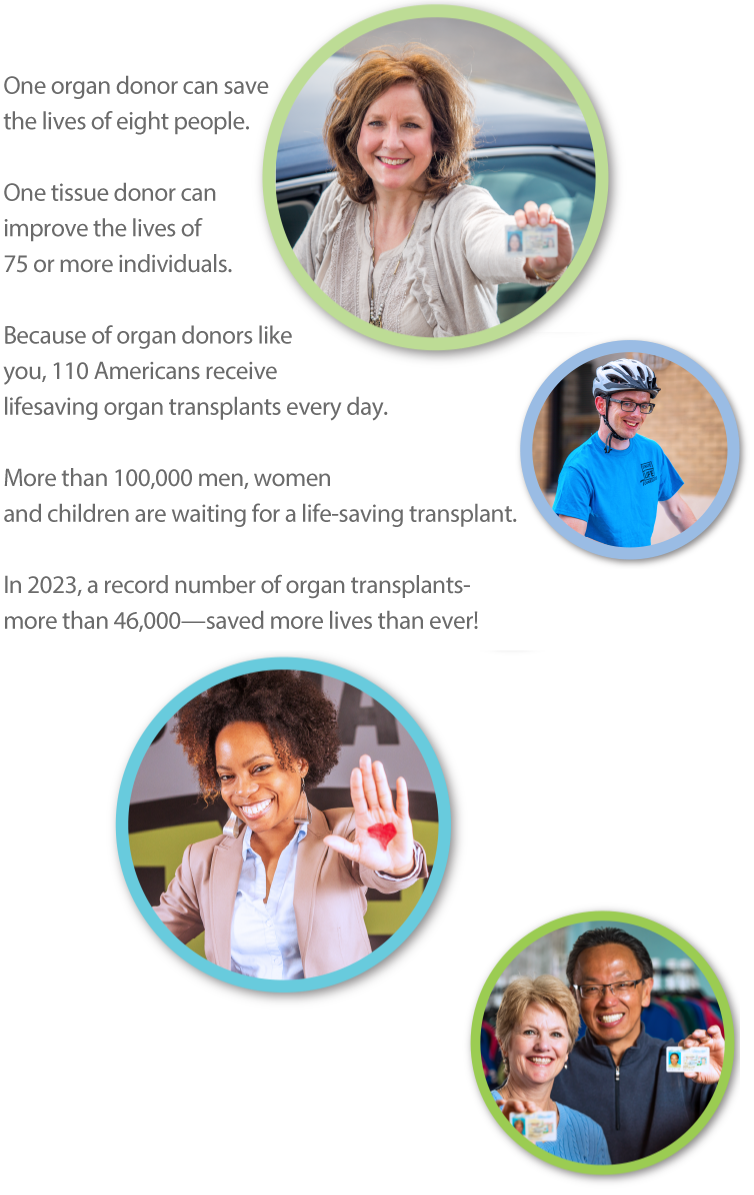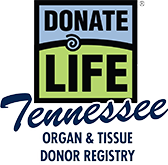
When You Register:
- You have the ability to give life to people who need organ and tissue transplants and contribute to groundbreaking research and education.
- You live on through grateful recipients and their families.
- You give legal consent to become an organ and tissue donor.*
* Revised Uniform Anatomical Gift Act of 2010 Tennessee Code Annotated Title 68, Chapter 30
You can choose to donate all of your organs and tissues or specify among the following:
Heart, lungs, liver, kidneys, pancreas, and small intestine
Skin, bones, ligaments, vertebral bodies, heart valves, pericardium, veins, blood vessels, nerves, and eyes/corneas
Click here for more detail on organs and tissues.
Organs
Heart
A heart transplant is a life-saving surgical procedure in which a malfunctioning heart is replaced with a healthy donor heart. The heart is responsible for circulation of blood throughout the body. Heart transplant recipients are generally people who suffer from long-term heart failure, heart muscle disease, severe birth defects or other irreversible heart injury from damage to the vessels of the heart that cannot be treated by any other medical or surgical means.
Kidneys
A kidney transplant is a life-saving surgical procedure performed to restore function to a recipient whose kidneys aren’t working as the result of disease. Kidneys are responsible for removing wastes from the body, regulating electrolyte balance and blood pressure and the stimulation of red blood cell production. A recipient may need a transplant because of primary kidney disease, congenital disease, urinary tract obstruction, high blood pressure, diabetic nephropathy or toxic reactions. Even though most people have two kidneys, one healthy kidney is able to function as if it were two, allowing for a normal, healthy and active life. Therefore, one donor’s kidneys are usually separated and transplanted into two recipients, saving two lives.
Small Intestine
Small intestine transplantation is the life-saving replacement of a unhealthy or surgically removed section of the small intestine. Key to the digestion process, the small intestine is responsible for the absorption of water, vitamins and nutrients. Small intestine recipients require a transplant as the result of diseases such as Crohn’s disease, diverticulitis or short bowel syndrome. Without a transplant, the patients have difficulty maintaining adequate nutrition and sometimes require intravenous feeding. Successful transplantation results in the recipient’s ability to eat normally and maintain nutritional health without intravenous feeding. The small intestine also can be transplanted in combination with other organs such as the pancreas, stomach and liver.
Lungs
A lung transplant is a life-saving surgical procedure performed to replace one or both diseased lungs with a healthy lung. The lungs are responsible for oxygenating the blood supply within the body. A person who needs a lung transplant may be suffering from lung disease such as emphysema, sarcoidosis, pulmonary hypertension or cystic fibrosis. Even though most people have two lungs, one healthy lung is usually able to function in place of two, allowing for a normal, healthy and active life. Therefore, a pair of lungs can be transplanted into two different recipients, saving two lives. A double-lung transplant, as well as a combination heart-lung transplant, can also be done for some patients.
Liver
A liver transplant is a life-saving surgical procedure performed to replace a diseased liver with a healthy one. The liver is the largest and one of the most complex internal organs in the body, with more than 400 functions. Damage to the liver can limit the absorption of vitamins and nutrients, prevent waste elimination and reduce the production of proteins needed to clot the blood. A person who needs a liver transplant may suffer from liver disease such as hepatitis, Wilson’s disease, blood clots, cirrhosis or autoimmune disease. In some cases, one donor liver can be separated into two separate lobes and transplanted into two recipients, saving two lives.
Pancreas
A pancreas transplant is a life-saving surgical procedure performed when a recipient’s own pancreas is diseased. The pancreas produces the hormones glucagon and insulin that help regulate levels of blood sugar (glucose) in your body. Pancreas recipients suffer from a form of diabetes sometimes called insulin-dependent or juvenile onset diabetes, which is the result of an attack on the insulin producing cells of the pancreas. The resulting lack of insulin leads to high blood sugar levels that must be treated with self-administered insulin injections. Despite this treatment, complications of diabetes often include visual disturbances, heart disease, nerve disorders and kidney disease. A pancreas transplant is the only cure for diabetes. Some patients require a kidney-pancreas transplant to treat both the pancreatic and kidney disease suffered as a result of diabetes. In this case, the same donor donates both the pancreas and the kidney.
Tissues
Bones
Bones can be transplanted in order to prevent amputation, promote healing, maintain mobility, and provide structure.
Bone grafts are transplanted during reconstructive orthopedic surgery, which results from injury or medical disorders that have limited the recipient’s activities of daily living. In some cases, a bone transplant prevents the loss of a limb for a recipient whose only alternative is amputation.
Eyes/Cornea
The parts of the eye which may be transplanted are corneas and the sclera, which is the white of the eye. The cornea is the most commonly and successfully transplanted portion of the eye. Corneal transplants are performed in an effort to restore sight to an individual whose vision has been compromised by a genetic defect, degenerative disease or traumatic injury. One donor can restore sight for two recipients.
Heart Valves
Heart valve transplantation is a lifesaving surgical procedure in which a recipient’s damaged valve is replaced with a functioning donor valve. The valves aid the heart’s ability to pump blood through the body. Heart valves are often transplanted into children born with congenital heart valve defects. One of the benefits of this type of procedure is children grow into a donated valve, which is superior to a synthetic alternative. In order to facilitate this gift, the heart is recovered and valves are removed from the heart for transplantation. One heart valve donor can save or heal the lives of several recipients. Heart valves are only donated when the heart cannot be donated as a functioning organ for medical reasons.
Pericardium
Pericardium transplants benefit recipients through orthopedic surgery and neurosurgery. Pericardium is the protective lining surrounding the heart in the chest. The lining is a membrane that can be successfully transplanted to replace the lining of the brain during neurosurgery, or in conjunction with surgery to repair sports-related injuries.
Skin
Skin can be used to aid the healing process for severe burn victims, hernia repairs, mastectomy repairs, or for those who suffer from a disfiguring injury or disease. Donated skin protects recipients from infection while promoting regeneration of their own skin.
Veins
Many people lose circulation in their legs, or even in their heart, due to disease or trauma. Donated veins can restore circulation in heart bypass surgeries and help prevent leg amputation for people suffering poor circulation.
Soft Tissue Tendons
Tendons can be used in a number of orthopedic surgeries. Recovered tendons are often used to repair ruptured ligaments (ACL repair). These surgeries allow the patients to return from an injury and regain full function.
Nerve
Nerve transplants are used to repair damages to the patient’s nerve. This can allow the patient to return feeling and motor control after a serious injury.
Transplant Only
Every effort will be made to transplant your organ, eye and tissue donation to a recipient in need. However, there are some instances when a suitable recipient cannot be identified. If you choose this option, and your donated gifts cannot be transplanted, they will be medically disposed.
Transplant and Research
Every effort will be made to transplant your organ, eye and tissue donation to a recipient in need. However, there are some instances when a suitable recipient cannot be identified. If you choose this option, and your donated gifts cannot be transplanted, every attempt will be made to place your gifts with a qualified facility that can use your donation to learn more about disease processes and treatments.


